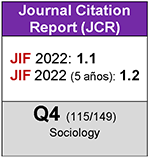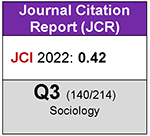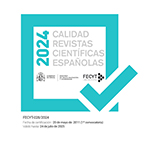The Economy that Lies Ahead. The Effects of Digital Social Relations on Work Productivity, Coordination and Independence
DOI:
https://doi.org/10.5477/cis/reis.184.85Keywords:
Digital Divide, Technological Capital, Social Networks, • Information and Communication Technologies, • WorkAbstract
The workplace is one of the environments that has most adapted to changes that have occurred in the context of the information and communication age. This study examines the effects of information and communication technologies (ICT) on Spanish workers, specifically, on their work performance, ability to coordinate with colleagues and on the possibility of achieving greater work independence. Two studies by the Spanish Centre for Sociological Research (2014 and 2016) on Digital Social Networks are used to meet this objective. The results indicate a greater probability of improving performance, coordination and work independence when using some ICT. Differences are also found in sociodemographic and socioeconomic status variables, which increase this probability in some cases when users are aware of the potential of a network of strong ties.
Downloads
References
Ala-Mutka, Kirsti (2011). Mapping Digital Competence: Towards a Conceptual understanding. European Commission. Publications Office of the European Union.
Anghel, Brindusa; Cozzolino, Marianela y Lacuesta, Aitor (2020). El teletrabajo en España. Madrid: Banco de España Eurosistema, Artículos Analíticos.
Bakas, Dimitrios; Kostis, Pantelis y Petrakis, Panagiotis (2020). «Culture and labour productivity: An empirical investigation». Economic Modelling, 85(C): 233-243. DOI: https://doi.org/10.1016/j.econmod.2019.05.020
Brunswicker, Sabine; Matei, Sorin A.; Zentner, Michael; Zentner, Linn y Klimeck, Gerhard (2017).
«Creating Impact in the Digital Space: Digital Practice Dependency in Communities of Digital Scientific Innovations». Scientometrics, 110: 417-442. doi: 10.1007/s11192-016-2106-z DOI: https://doi.org/10.1007/s11192-016-2106-z
Burt, Ronald S. (1992). Structural Holes: The Social Structure of Competition. Cambridge, Massachusetts: Harvard University Press. DOI: https://doi.org/10.4159/9780674029095
Burt, Ronald S. (1997). «The Contingent Value of Social Capital». Administrative Science Quarterly, 42: 339-365. doi: 10.2307/2393923 DOI: https://doi.org/10.2307/2393923
Burt, Ronald S. (2000). «The Network Structure of Social Capital». Research in Organizational Behavior, 22: 345-423. doi: 10.1016/S0191-3085(00)22009-1 DOI: https://doi.org/10.1016/S0191-3085(00)22009-1
Burt, Ronald S. (2004). «Structural Holes and Good Ideas». American Journal of Sociology, 110: 349399. doi: 10.1086/421787 DOI: https://doi.org/10.1086/421787
Cabero, Julio (2004). Reflexiones sobre la brecha digital y la educación. [Conference session]. Tecnoneet 2004: Retos y realidades de la Inclusión Digital. Murcia, España.
Calderón-Gómez, Daniel; Casas-Mas, Belén; Urraco Solanilla, Mariano y Revilla, Juan C. (2020). «The Labour Digital Divide: Digital Dimensions of LabourMarket Segmentation». Work Organisation Labour y Globalisation, 14(2): 7-30. doi: 10.13169/workorgalaboglob.14.2.0007 DOI: https://doi.org/10.13169/workorgalaboglob.14.2.0007
Castells, Manuel (1996). The information Age: Economy, Society and Culture. Volume I: The Rise of the Network Society. Cambridge, Massachusetts: Blackwell.
Castells, Manuel (2001). The Internet Galaxy: Reflections on the Internet, Business, and Society. New York: Oxford University Press. DOI: https://doi.org/10.1007/978-3-322-89613-1
Castells, Manuel (2006). La Sociedad red: una visión global. Madrid: Alianza Editorial.
Castells, Manuel y Tubella, Imma (2007). La transición a la sociedad red. Barcelona: Ariel.
Coleman, James (1988). «Social Capital in the Creation of Human Capital». American Journal of Sociology, 94: 95-120. Disponible en: https://www.jstor.org/ stable/2780243, acceso 20 de marzo de 2020. DOI: https://doi.org/10.1086/228943
Coleman, James (1990). Foundations of Social Theory. Cambridge: Harvard University Press.
Collet, David (2003). Modelling Binary Data. London: Chapman y Hall - CRC.
Cunha, João V. da y Orlikowski, Wanda J. (2008).
«Performing Catharsis: The Use of Online Discussion Forums in Organizational Change». Information and Organization, 18(2): 132-156. doi: 10.1016/j.infoandorg.2008.02.001 DOI: https://doi.org/10.1016/j.infoandorg.2008.02.001
Davis, Fred D. (1986). A Technological Acceptance Model for Empirical Testing New End-user Information Systems: Theory and Results. Cambridge: MIT Sloan School of Management.
Davis, Fred D. (1989). «Perceived Usefulness, Perceived Ease of Use and User Acceptance of Information Technology». MIS Quarterly, 13: 319-340. doi: 10.2307/249008 DOI: https://doi.org/10.2307/249008
Davison, Robert M.; Ou, Carol X. J.; Martinsons, Maris. G.; Zhao, Angela Y. y Du, Rong (2014).
«The Communicative Ecology of Web 2.0 at Work: Social Networking in the Workspace: A Case Study». Journal of the Association for Information Science and Technology, 65(10): 2035-2047. doi: org/10.1002/asi.23112 DOI: https://doi.org/10.1002/asi.23112
Dewan, Sanjeev y Riggins, Frederick J. (2005). «The Digital Divide: Current and Future Research Directions». Journal of the Association for Information Systems, 6(12): 298-337. doi: 10.17705/1jais.00074 DOI: https://doi.org/10.17705/1jais.00074
Dierckx, Marcel A. F. y Stroeken, Jan H. M. (1999).
«Information Technology and Innovation in Small and Medium-sized Enterprises». Technological Forecasting and Social Change, 60(2): 149-166. doi: 10.1016/S0040-1625(98)00043-2 DOI: https://doi.org/10.1016/S0040-1625(98)00043-2
DiMaggio, Paul; Hargittai, Eszter; Neuman, Russel y Robinson, John P. (2001). «Social Implications of the Internet». Annual Review of Sociology, 27: 307-336. doi: 10.1146/annurev.soc.27.1.307 DOI: https://doi.org/10.1146/annurev.soc.27.1.307
Dua, Pami y Garg, Niti K. (2019). «Determinants of Labour Productivity: Comparison between Developing and Developed Countries of Asia-Pacific». Pacific Economic Review, 24(5): 686-704. DOI: https://doi.org/10.1111/1468-0106.12294
European Commission (2019). The Digital Economy and Society Index (DESI). Disponible en: https:// ec.europa.eu/digital-single-market/en/desi, acceso 15 de abril de 2020.
Francis, Jess; Ball, Christopher; Kadylak, Travis y Cotten, Shelia R. (2019). «Aging in the Digital Age: Conceptualizing Technology Adoption and Digital Inequalities». En: B. B. Neves y F. Vetere (ed.). Ageing and Digital Technology, (pp. 35-49). Singapore: Springer. DOI: https://doi.org/10.1007/978-981-13-3693-5_3
Freeman, Linton C. (2004). The development of social network analysis: A study in the sociology of science. Vancouver: Empirical Press.
Granovetter, Mark (1973). «The Strength of Weak Ties». American Journal of Sociology, 78(6): 1360-1380. Disponible en: http://www.jstor.org/ stable/2776392, acceso 14 de marzo de 2020. DOI: https://doi.org/10.1086/225469
Granovetter, Mark (1985). «Economic action and social structure: The problem of embeddedness». American Journal of Sociology, 91: 481-510. Disponible en: https://www.jstor.org/stable/2780199, acceso 14 de marzo de 2020. DOI: https://doi.org/10.1086/228311
Granovetter, Mark (2005). «The Impact of Social Structure on Economic Outcomes». Journal of Economic Perspectives, 19(1): 33-50. doi: 10.1257/0895330053147958 DOI: https://doi.org/10.1257/0895330053147958
Gray, Peter H.; Parise, Salvatore e Iyer, Bala (2011). «Innovation Impacts of Using Social Bookmarking Systems». MIS Quarterly, 35(3): 629-643. doi: 10.2307/23042800 DOI: https://doi.org/10.2307/23042800
Hair, Joseph F.; Black, William C.; Babin, Barry J. y Anderson, Rolph E. (2014). Multivariate Data Analysis. Essex, England: Pearson Education Limited.
Hampton, Keith y Wellman, Barry (2001). «Long distance community in the network society: Contact and support beyond netville». American Behavioral Scientist, 45(3): 476-495. doi: 10.1177/00027640121957303 DOI: https://doi.org/10.1177/00027640121957303
Kilduff, Martin y Brass, Daniel J. (2010). «Organizational Social Network Research: Core Ideas and Key Debates». The Academy of Management Annals, 4(1): 317-357. doi: 10.1080/19416520.2010.494827 DOI: https://doi.org/10.5465/19416520.2010.494827
Kline, Joel y Konstanze, Alex B. (2013). «The Social Body of Knowledge: Nurturing Organizational Social Capital via Social Media Based Communities of Practice». Technical Communication, 60(4): 279-292. Disponible en: https://www.jstor.org/stable/26464357, acceso 18 de septiembre de 2021.
Leonardi, Paul M. y Barley, Stephen R. (2010). «What’s Under Construction Here? Social Action, Materiality, and Power in Constructivist Studies of Technology and Organizing». Academy of Management Annals, 4: 1-51. doi: 10.1080/19416521003654160 DOI: https://doi.org/10.5465/19416521003654160
Leonardi, Paul M. y Neeley, Tsedal (2022). The digital mindset: What it really takes to thrive in the age of data, algorithms, and AI. Brighton, Massachusetts: Harvard Business Review Press.
López, Carolina y Soto, Pedro (2010). «Analyzing ICT Adoption and Use Effects on Knowledge Creation: An Empirical Investigation in SMEs». International Journal of Information Management, 30(6): 521-
doi: 10.1016/j.ijinfomgt.2010.03.004 DOI: https://doi.org/10.1016/j.ijinfomgt.2010.03.004
Mann, Laura (2014). The Digital Divide and Employment. In: Society and the Internet: How Networks of Information and Communication are Changing our Lives. Oxford: Oxford University Press. DOI: https://doi.org/10.1093/acprof:oso/9780199661992.003.0019
Moqbel, Murad; Saggi, Nevo y Kock, Ned (2013).
«Organizational Members. Use of Social Networking Sites and Job Performance: An Exploratory Study». Information Technology y People, 26(3): 240-264. doi: 10.1108/ITP-10-2012-0110 DOI: https://doi.org/10.1108/ITP-10-2012-0110
Mumford, Enid (2006). «The Story of Socioechnical Design: Reflections in its Successes, Failures and Potential». Information Systems Journal, 16: 317-342. doi: 10.1111/j.1365-2575.2006.00221.x DOI: https://doi.org/10.1111/j.1365-2575.2006.00221.x
Neff, Gina (2005). «The Changing Place of Cultural Production: The Location of Social Networks in a Digital Media Industry». The ANNALS of the American Academy of Political and Social Science, 597(1): 134-152. doi: 10.1177/0002716204270505 DOI: https://doi.org/10.1177/0002716204270505
Newman, Alexander; Round, Heather; Wang, Shuanglong H. y Mount, Matthew (2019). «Innovation Climate: A Systematic Review of the Literature and Agenda for Future Research». Journal of Occupational and Organizational Psychology, 93(1): 73-109. doi: 10.1111/joop.12283 DOI: https://doi.org/10.1111/joop.12283
Norris, Pippa (2001). Digital divide? Civic Engagement, Information Poverty and the Internet Worldwide. Cambridge: Cambridge University Press. DOI: https://doi.org/10.1017/CBO9781139164887
Park, Sora (2017). Digital Capital. London: Palgrave Macmillan. DOI: https://doi.org/10.1057/978-1-137-59332-0
Patterson, Malcolm G.; West, Michael A.; Shackleton, Viv J.; Dawson, Jeremy F.; Lawthom, Rebecca; Maitlis, Sally; Robinson, David L. y Wallace, Alison
M. (2005). «Validating the Organizational Climatemeasure: Links to Managerial Practices, Productivity and Innovation». Journal of Organizational Behavior, 26: 379-408. doi: 10.1002/job.312 DOI: https://doi.org/10.1002/job.312
Pigg, Kenneth E. y Cranck, Laura D. (2004). «Building Community Social Capital: The Potential and Promise of Information and Communications Technologies». The Journal of Community Informatics, 1(1): 58-73. doi: 10.15353/joci.v1i1.2062 DOI: https://doi.org/10.15353/joci.v1i1.2062
Ragnedda, Massimo y Destefanis, Giuseppe (eds.). (2021). Blockchain and Web 3.0: Social, Economic, and Technological Challenges. London: Routledge.
Ragnedda, Massimo; Ruiu, Maria L.; Addeo, Felice y Paoli, Andrea D. (2022). «Converting Digital Capital in Five Key Life Realms». Italian Sociological Review, 12(1): 19-40.
Rainie, Lee y Wellman, Barry (2012). Networked: The new social operating system. Cambridge, Massachusetts: The MIT Press. DOI: https://doi.org/10.7551/mitpress/8358.001.0001
Requena, Félix (1991). Redes Sociales y Mercado de Trabajo. Madrid: Centro de Investigaciones Sociológicas y Siglo XXI.
Requena, Félix (2003). «Social capital, satisfaction and quality of life in the workplace». Social Indicators Research, 61: 331-360. doi: 10.1023/ A:1021923520951 DOI: https://doi.org/10.1023/A:1021923520951
Requena, Félix (2008). Redes sociales y sociedad civil. Madrid: CIS.
Requena, Félix y Ayuso, Luis (2019). «Individualism or complementarity? The Effect of Digital Personal networks on Face-to-Face Personal Networks». Information, Communication y Society, 22(14): 2097-2111. doi: 10.1080/1369118X.2018.1477968 DOI: https://doi.org/10.1080/1369118X.2018.1477968
Ruiz-Torres, Paula (2021). COVID-19: Teletrabajo en tiempos de pandemia. Ediciones Complutense. Disponible en: https://revistas.ucm.es/index. php/ HICS/article/view/74237/4564456555847, acceso 25 de octubre de 2022.
Selwyn, Neil (2002). «Defining the ‘Digital Divide’: Developing a Theoretical Understanding of Inequalities in the Information Age». Occasional Paper, 49. Cardiff University. Disponible en: http://www.cf.ac. uk/socsi/ict/definingdigitaldivide.pdf, acceso 7 de octubre de 2020.
Selwyn, Neil (2004). «Reconsidering Political and Popular Understandings of the Digital Divide». New Media y Society, 6(3): 341-362. doi: 10.1177/1461444804042519 DOI: https://doi.org/10.1177/1461444804042519
Souza e Silva, Adriana de y Xiong-Gum, Mai N. (2020). «Mobile Networked Creativity: Developing a Theoretical Framework for Understanding Creativity as Survival». Communication Theory. DOI: https://doi.org/10.33767/osf.io/4fkev
Torrent, Joan y Vilaseca, Jordi (2007). La economía del conocimiento y la empresa red. En: J. Torrent y
J. Vilaseca (dirs.). La empresa red. Tecnologías de la Información y la Comunicación, Productividad y Competitividad (pp. 29-79). Barcelona: Ariel.
Torrent, Joan y Ficapal, Pilar (2010a). «TIC, coinnovación y productividad empresarial: Evidencia empírica para Cataluña y comparación internacional de resultados». Revista de Economía Mundial, 26: 203-233.
Torrent, Joan y Ficapal, Pilar (2010b). «¿Nuevas fuentes co-innovadoras de la productividad empresarial?». Innovar, 20(38): 111-124. Disponible en: https://revistas.unal.edu.co/index.php/innovar/article/view/22295, acceso 17 de julio de 2019.
Torres, Cristobal; Robles, José M.; De Marco, Stefano y Antino, Mirko (2017). «Revisión analítica del modelo de aceptación de la tecnología. El cambio tecnológico». Papers-Revista de Sociología, 102(1): 5-27. doi: 10.5565/rev/papers.2233 DOI: https://doi.org/10.5565/rev/papers.2233
Varlamova, Julia y Larionova, Natalia (2020). «Labor Productivity in the Digital Era: A Spatial-Temporal Analysis». International Journal of Technology, 11(6): 1191-1200. doi: 10.14716/ijtech.v11i6.4429 DOI: https://doi.org/10.14716/ijtech.v11i6.4429
Wellman, Barry; Quan Haase, Anabel; Witte, James y Hampton, Keith (2001). «Does the Internet Increase, Decrease, or Supplement Social Capital? Social Networks, Participation, and Community Commitment». American Behavioral Scientist, 45(3): 436-455. doi: 10.1177/00027640121957286 DOI: https://doi.org/10.1177/00027640121957286
Yan, Yalan; Davison, Robert M. y Mo, Chunyan (2013). «Employee Creativity Formation: The Roles of Knowledge Seeking, Knowledge Contributing and Flow Experience in Web 2.0 Virtual Communities». Computers in Human Behavior, 29(5): 1923-1932. doi: 10.1016/j.chb.2013.03.007 DOI: https://doi.org/10.1016/j.chb.2013.03.007
Yuan, Sun y Shang, Rong-An (2014). «The Interplay between Users Intraorganizational Social Media Use and Social Capital». Computers in Human Behavior, 37: 334-341. doi: 10.1016/j.chb.2014.03.048 DOI: https://doi.org/10.1016/j.chb.2014.03.048
Downloads
Published
How to Cite
Issue
Section
License
Copyright (c) 2023 REIS. Revista Española de Investigaciones Sociológicas

This work is licensed under a Creative Commons Attribution-ShareAlike 4.0 International License.
Permite Compartir — copiar y redistribuir el material en cualquier medio o formato, Adaptar — remezclar, transformar y construir a partir del material para cualquier propósito, incluso comercialmente.








